八年级下仁爱英语UNIT5TOPIC3教案教案资料
- 格式:doc
- 大小:219.51 KB
- 文档页数:16
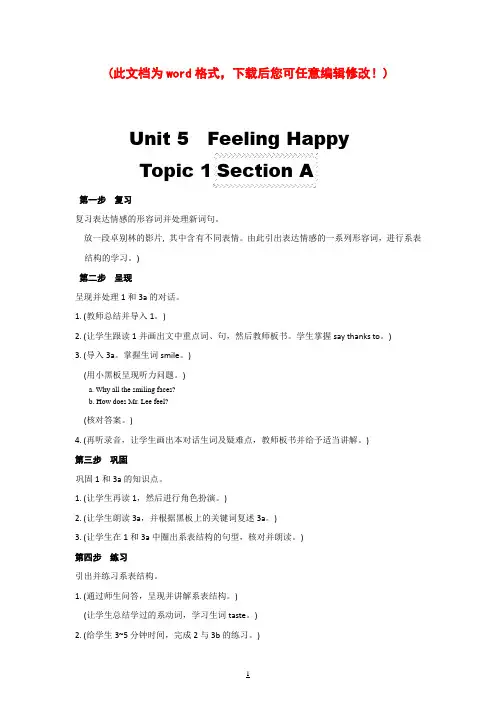
(此文档为word格式,下载后您可任意编辑修改!) Unit 5 Feeling HappyTopic 1Section A第一步复习复习表达情感的形容词并处理新词句。
放一段卓别林的影片, 其中含有不同表情。
由此引出表达情感的一系列形容词,进行系表结构的学习。
)第二步呈现呈现并处理1和3a的对话。
1. (教师总结并导入1。
)2. (让学生跟读1并画出文中重点词、句,然后教师板书。
学生掌握say thanks to。
)3. (导入3a。
掌握生词smile。
)(用小黑板呈现听力问题。
)a. Why all the smiling faces?b. How does Mr. Lee feel?(核对答案。
)4. (再听录音,让学生画出本对话生词及疑难点,教师板书并给予适当讲解。
)第三步巩固巩固1和3a的知识点。
1. (让学生再读1,然后进行角色扮演。
)2. (让学生朗读3a,并根据黑板上的关键词复述3a。
)3. (让学生在1和3a中圈出系表结构的句型,核对并朗读。
)第四步练习引出并练习系表结构。
1. (通过师生问答,呈现并讲解系表结构。
)(让学生总结学过的系动词,学习生词taste。
)2. (给学生3~5分钟时间,完成2与3b的练习。
)第五步综合探究活动合作探究本课重点词句。
1. (让学生自我测试,通过反义词学习生词。
)2. Homework:Section B第一步复习复习并处理新词句,然后导入新课。
(检查上节课布置的作业,复习系表结构,导出本课的目标语言。
要求学生理解生词upset,掌握短语be proud of。
)第二步呈现呈现并处理本课活动1和3a。
1. (通过谈论京剧,引入本课重点活动1。
要求学生掌握film,理解Beijing Opera,了解moving。
) (让学生听1的录音,回答教师问题。
听完录音后,教师提问。
)2. (呈现3a。
学习并掌握短语set the table和be able to。
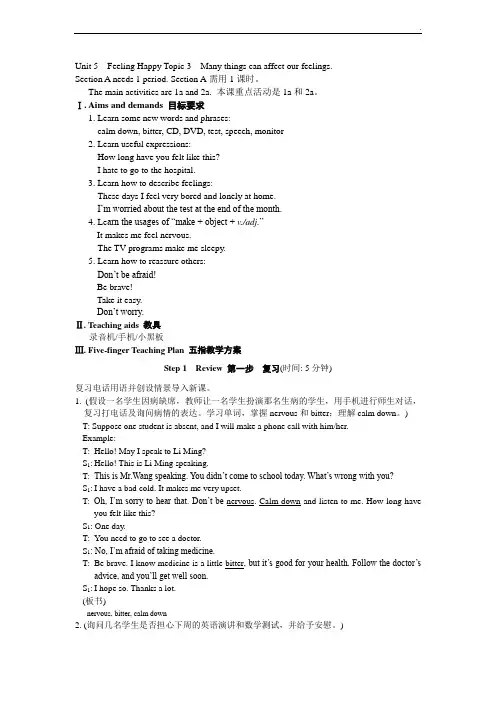
Unit 5 Feeling Happy Topic 3 Many things can affect our feelings.Section A needs 1 period. Section A需用1课时。
The main activities are 1a and 2a. 本课重点活动是1a和2a。
Ⅰ. Aims and demands 目标要求1. Learn some new words and phrases:calm down, bitter, CD, DVD, test, speech, monitor2. Learn useful expressions:How long have you felt like this?I hate to go to the hospital.3. Learn how to describe feelings:These days I feel very bored and lonely at home.I’m worried about the test at the end of the month.4. Le arn the usages of “make + object + v./adj.”It makes me feel nervous.The TV programs make me sleepy.5. Learn how to reassure others:Don’t be afraid!Be brave!Take it easy.Don’t worry.Ⅱ. Teaching aids 教具录音机/手机/小黑板Ⅲ. Five-finger Teaching Plan 五指教学方案Step 1 Review 第一步复习(时间: 5分钟)复习电话用语并创设情景导入新课。
1. (假设一名学生因病缺席,教师让一名学生扮演那名生病的学生,用手机进行师生对话,复习打电话及询问病情的表达。
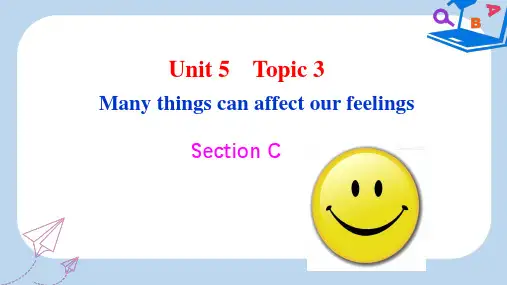
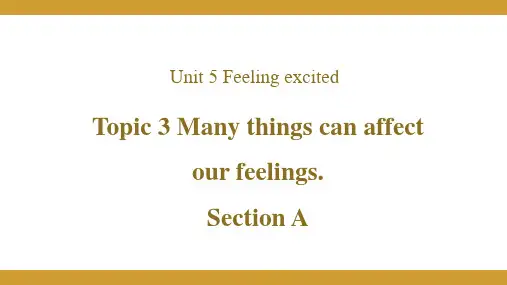
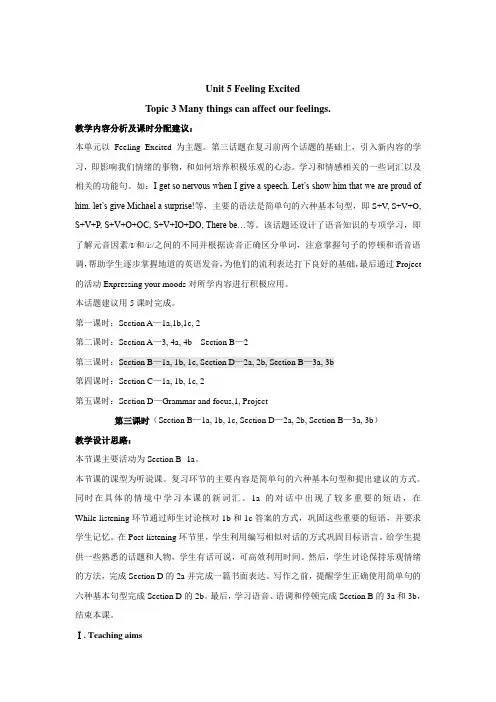
Unit 5 Feeling ExcitedTopic 3 Many things can affect our feelings.教学内容分析及课时分配建议:本单元以Feeling Excited 为主题。
第三话题在复习前两个话题的基础上,引入新内容的学习,即影响我们情绪的事物,和如何培养积极乐观的心态。
学习和情感相关的一些词汇以及相关的功能句。
如:I get so nervous when I give a speech. Let’s show him that we are proud of him. let’s give Michael a surprise!等,主要的语法是简单句的六种基本句型,即S+V, S+V+O, S+V+P, S+V+O+OC, S+V+IO+DO, There be…等。
该话题还设计了语音知识的专项学习,即了解元音因素/ɪ/和/i:/之间的不同并根据读音正确区分单词,注意掌握句子的停顿和语音语调,帮助学生逐步掌握地道的英语发音,为他们的流利表达打下良好的基础,最后通过Project 的活动Expressing your moods对所学内容进行积极应用。
本话题建议用5课时完成。
第一课时:Section A—1a,1b,1c, 2第二课时:Section A—3, 4a, 4b Section B—2第三课时:Section B—1a, 1b, 1c, Section D—2a, 2b, Section B—3a, 3b第四课时:Section C—1a, 1b, 1c, 2第五课时:Section D—Grammar and focus,1, Project第三课时(Section B—1a, 1b, 1c, Section D—2a, 2b, Section B—3a, 3b)教学设计思路:本节课主要活动为Section B -1a。
本节课的课型为听说课。
复习环节的主要内容是简单句的六种基本句型和提出建议的方式。
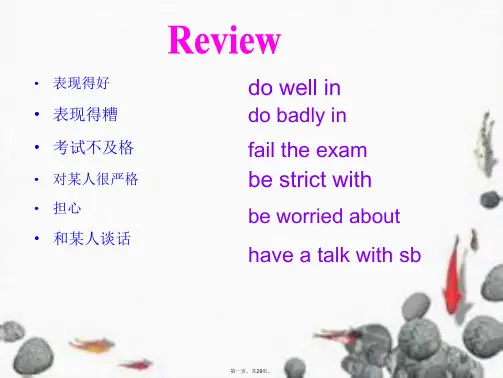
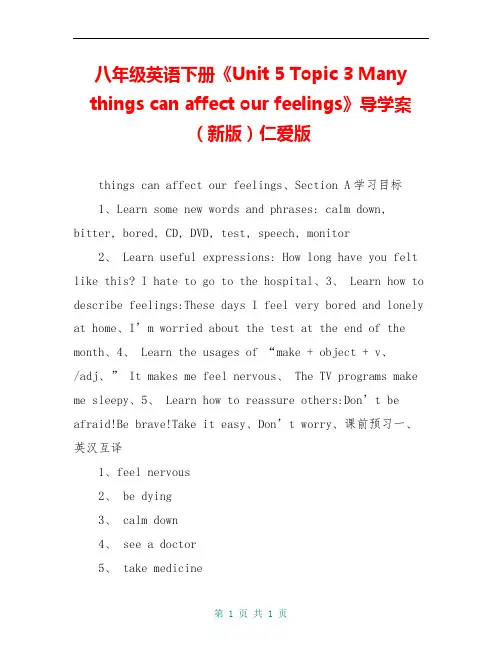
八年级英语下册《Unit 5 Topic 3 Many things can affect our feelings》导学案(新版)仁爱版things can affect our feelings、Section A学习目标1、Learn some new words and phrases: calm down, bitter, bored, CD, DVD, test, speech, monitor2、 Learn useful expressions: How long have you felt like this? I hate to go to the hospital、3、 Learn how to describe feelings:These days I feel very bored and lonely at home、I’m worried about the test at the end of the month、4、Learn the usages of “make + object + v、/adj、” It makes me feel nervous、 The TV programs make me sleepy、5、Learn how to reassure others:Don’t be afraid!Be brave!Take it easy、Don’t worry、课前预习一、英汉互译1、feel nervous2、 be dying3、 calm down4、 see a doctor5、 take medicine6、 miss lessons7、听医生的建议8、在月底9、轮流做某事10、自学11、做演讲12、好好照顾二、根据首字母提示填空1、There is gong to be an English t tomorrow、2、Black coffee leaves a b taste in the mouth、3、 The soldier gave a s about saving people in Wenchuan、 All the people were moved and cried、4、I’m a shy girl、 I always feel n when I speak in public、5、Jane’s teacher made her m 、 she agreed、课堂环节1、复习电话用语并创设情景导入新课。
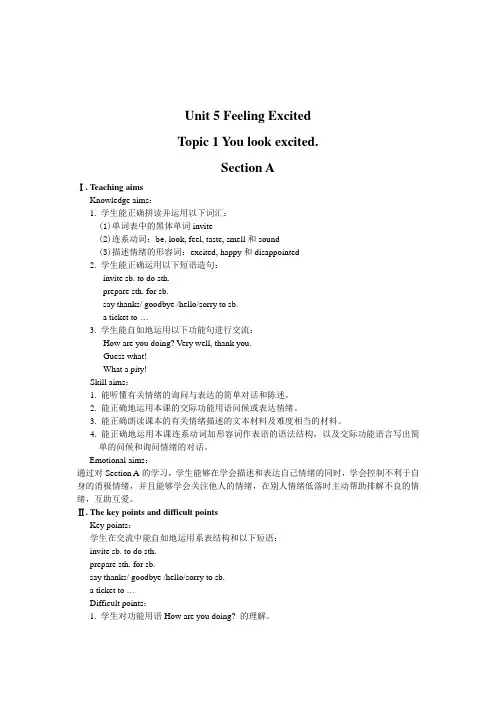
Unit 5 Feeling ExcitedTopic 1 You look excited.Section AⅠ. Teaching aimsKnowledge aims:1. 学生能正确拼读并运用以下词汇:(1)单词表中的黑体单词invite(2)连系动词:be,look, feel, taste, smell和sound(3)描述情绪的形容词:excited, happy和disappointed2. 学生能正确运用以下短语造句:invite sb. to do sth.prepare sth. for sb.say thanks/ goodbye /hello/sorry to sb.a ticket to …3. 学生能自如地运用以下功能句进行交流:How are you doing? Very well, thank you.Guess what!What a pity!Skill aims:1. 能听懂有关情绪的询问与表达的简单对话和陈述。
2. 能正确地运用本课的交际功能用语问候或表达情绪。
3. 能正确朗读课本的有关情绪描述的文本材料及难度相当的材料。
4. 能正确地运用本课连系动词加形容词作表语的语法结构,以及交际功能语言写出简单的问候和询问情绪的对话。
Emotional aims:通过对Section A的学习,学生能够在学会描述和表达自己情绪的同时,学会控制不利于自身的消极情绪,并且能够学会关注他人的情绪,在别人情绪低落时主动帮助排解不良的情绪,互助互爱。
Ⅱ. The key points and difficult pointsKey points:学生在交流中能自如地运用系表结构和以下短语:invite sb. to do sth.prepare sth. for sb.say thanks/ goodbye /hello/sorry to sb.a ticket to …Difficult points:1. 学生对功能用语How are you doing? 的理解。
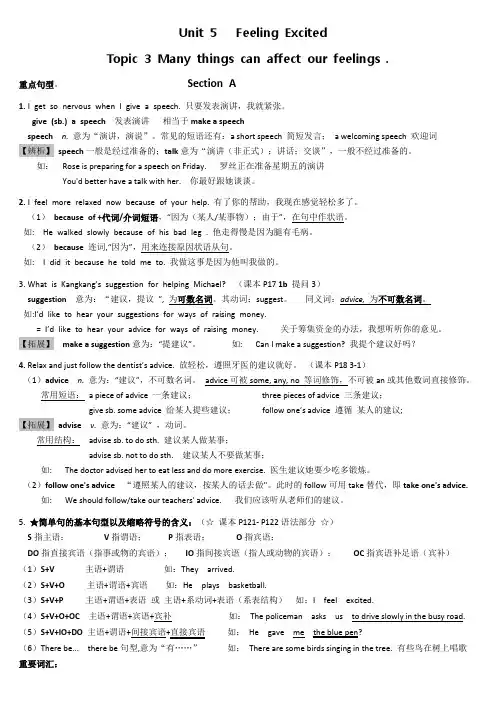
Unit5 Feeling ExcitedTopic3Many things can affect our feelings.重点句型。
Section A1. I get so nervous when I give a speech. 只要发表演讲,我就紧张。
give (sb.) a speech 发表演讲相当于make a speechspeech n.意为“演讲,演说”。
常见的短语还有:a short speech 简短发言;a welcoming speech 欢迎词【辨析】speech一般是经过准备的;talk意为“演讲(非正式);讲话;交谈”,一般不经过准备的。
如:Rose is preparing for a speech on Friday. 罗丝正在准备星期五的演讲You'd better have a talk with her. 你最好跟她谈谈。
2. I feel more relaxed now because of your help. 有了你的帮助,我现在感觉轻松多了。
(1)because of +代词/介词短语,“因为(某人/某事物);由于”,在句中作状语。
如: He walked slowly because of his bad leg . 他走得慢是因为腿有毛病。
(2)because 连词,“因为”,用来连接原因状语从句。
如: I did it because he told me to. 我做这事是因为他叫我做的。
3. What is Kangkang’s suggestion for helping Michael? (课本P17 1b 提问3)suggestion意为:“建议,提议”,为可数名词。
其动词:suggest。
同义词:advice,为不可数名词。
如:I’d like to hear your suggestions for ways of raising money.= I’d like to hear your advice for ways of raising money. 关于筹集资金的办法,我想听听你的意见。

Topic3 SectionD教材知识详解1.If we are in good spirits, we can study or work better.假如我们有良好的情绪,我们就能更好地学习或者工作。
in good/high spirits意为“心情好,情绪高昂”,其反义短语为in bad/low spirits意为“心情不好,情绪低落”。
如:They are singing and dancing in high spirits.他们情绪高昂,又唱又跳。
He said nothing. Obviously he was in low spirits.他一言不发,显然是情绪低落。
in a good mood心情愉悦in a bad mood心情糟糕in good health健康状况良好。
如:He often takes exercise, so he is in good health.他经常锻炼,所以身体健康。
2. Don’t keep silent.不要默不作声。
silent adj.沉默的,不说话的。
如:He is a silent, thoughtful boy.他是个沉默多思的孩子。
silence n.寂静,沉默。
如:We all walked on in silence.我们都默默地向前走。
3.Think it over before making an important decision.在你做重要决定之前一定要仔细考虑。
think over仔细考虑,慎重考虑。
如:Why don’t you think it over for a while?为什么你不多认真考虑一会儿呢?与think有关的短语有:①think about考虑;回想;想起。
如:I’ll think about it.我会考虑这事的。
②think of认为;想到。
如:What do you think of the film?你认为这部电影怎么样?Then he thought of me.后来他想到了我。

仁爱版英语八年级下册整册教案Unit6 Enjoying CyclingTopic 1 We’re going on a spring field tripSection A说课稿一、说教材1. 教材分析仁爱版初中英语教材共六册,每册由四个模块组成,每个模块由单元-———话题————功能——-任务构成,编写思路清晰,符合学生的认识发展规律.八年级英语下册第六单元Topic1 Section A讲述了让学生学习如何用英语谈论旅游,并收集旅游信息。
它由3部分组成,用1课时完成。
通过学习Section A,学生可以更多的了解旅游知识并提高实际能力;动词不定式是本节课的重点语法项目。
2.教学目标(1).知识目标要求学生牢记Section A所有新学的四会单词.短语和重点句型;掌握不定式“to do"的用法。
(2).技能目标:能用英语与他人谈论关于旅游的话题。
培养学生提高语言交际能力,能在小组中积极与他人协作,从而开阔自己的视野,扩大知识面.(3).情感目标培养学生爱护大自然,热爱旅游.积极参与课堂上各种英语实践活动的兴趣.培养学生分工合作和团体协作精神.3.教学重点和难点(1)。
重点:谈论关于旅游的话题。
(2)。
重点和难点:不定式“to do”的用法。
二。
说学情1.学生对旅游较感兴趣,但对旅游知识了解较少.2。
学生的词汇量掌握不多.3. 学生平时较少用英语与他人交谈并表达信息..三。
说教法学法按照课程改革的要求,遵循“老师由主演变导演,学生由配角变主角”的角色转换,采用把课堂交给学生的教学理论,我运用自由讨论。
分组工作.结对练习。
问答练习等方法,借助多媒体、录音机,图片等教学手段,设置特定的语言环境,使学生在轻松愉快的气氛中理解.运用英语。
四.说教学程序我设计了以下的步骤来训练学生的听.说。
读。
写的能力,尤其是他们“说”的能力。
(一)温故知新(1).请两位学生用上节课重点句型号,分别复述Unit 5 Topic3 Section D 1a(2).教师与学生之间进行问答对话,让学生谈论关于他们最喜爱的旅游方式.设计意图:巩固上节课学过的知识,为学习新课铺垫.(二)情景导入用多媒体展示一些关于旅游和交通的图片,来引起学生的兴趣,并由此教学本节课的新单词,如:field ,trip ,cycle ,vehicle ,airline等。
Unit 5 Feeling ExcitedTopic 3 Many things can affect our feelings.Section A 教学设计Ⅰ. Material analysis本节课为话题的第一节课,建议用两课时上完。
主要活动为1a和4a。
本课通过Kangkang帮助Michael缓解演讲前的紧张情绪,引出对话的主题:描述影响心情和情绪的事情和具体事物。
对话呈现了重点词汇:test, nervous和speech, 充分表现了Michael 发表演讲前的焦虑;通过3 的听力练习,继续呈现了几组学生们在生活中经常发生的会影响心情的场景并给予合理的处理建议;最后以4a中提供的情境作为载体,向学生呈现了简单句的六种基本句型,使学生系统地掌握简单句的构成。
Ⅱ. Teaching aimsKnowledge aims:1. 学生能正确拼读并运用单词表中的黑体单词test, nervous和speech。
2. 学生能正确运用以下短语造句:h ave a test, get nervous, give a speech, follow one’s advice, fall off…3. 学生能自如地运用以下询问心情、表示安慰和提出建议的功能句进行交流。
Is there anything wrong?How are you doing?What’s wrong?Don’t worry.Take it easy.Why not …?4. 学生能正确地运用相关的交际功能用语写出有关情绪询问和给出建议的对话。
Skill aims:1. 能听懂有关询问影响心情的事情和提出建议的简单对话和陈述。
2. 能正确地运用本课的交际功能用语进行询问和给出建议。
3. 能正确朗读课本的有关情绪询问和给出建议的文本材料及难度相当的材料。
4. 能正确地运用本课新呈现的短语,简单句和交际功能语言写出简单的有关情绪询问和给出建议的对话。
Unit5 Feeling ExcitedTopic1 You look excited.教学内容分析及课时分配建议:本单元以Feeling Excited 为主题。
第一话题通过Kangkang和朋友们谈论他们的父母以及Mr.Brown去看电影的有关事件,学习问候、转达感谢、表达观点和看法、表示遗憾等的表达法;主要句型和语法是感官动词的基本用法,如:You look excited.和How does the music sound?同时,还学习有关情绪和感受的形容词。
如:lonely, frightened, worried, interested, upset, surprised等,并通过Project的活动以作报告的形式介绍自己最喜欢的电影、剧目或者故事,对本话题所学内容进行真实的应用。
本话题建议用5个课时来完成。
第一课时:Section A-1a, 1b, 1c, 1d, 2第二课时:Section A-4,3 Section B-1a,1b,1c第三课时:Section B-2a,2b,3,4a,4b第四课时:Section C-1a,1b,1c,2a,2b,3第五课时:Section D-Grammar and Functions, 1, 2a, 2b, Project第三课时(Section B-2a,2b,3,4a,4b)教学设计思路:本节课主要活动为Section B-2a,2b,3。
以词汇和语音语调的学习为主。
复习导入仍以系动词的基本用法为主,以师生讨论的方式复习情绪形容词的用法,引出形容词的概念。
学生总结情绪形容词,教师板书并分类。
接下来进入Section B-2a的学习。
学生观察2a的词汇,归纳构词法。
教师鼓励学生说出更多类似的词汇,补充板书。
在巩固环节利用刚刚总结的形容词的分类及用法知识完成2b和3的练习。
在语音和语调环节完成4a和4b的教学活动,鼓励学生总结ed的发音。
Topic 3 Many things can affect our feelings.Section ASection A needs 1 period. Section A需用1课时。
The main activities are 1a and 2a. 本课重点活动是1a和2a。
Ⅰ. Aims and demands 目标要求1. Learn some new words and phrases:calm down, bitter, CD, DVD, test, speech, monitor2. Learn useful expressions:How long have you felt like this?I hate to go to the hospital.3. Learn how to describe feelings:These days I feel very bored and lonely at home.I’m worried about the test at the end of the month.4. Learn the usages of “make + object + v./adj.”It makes me feel nervous.The TV programs make me sleepy.5. Learn how to reassure others:Don’t be afraid!Be brave!Take it easy.Don’t worry.Ⅱ. Teaching aids 教具录音机/手机/小黑板Ⅲ. Five-finger Teaching Plan 五指教学方案Step 1 Review 第一步复习(时间: 5分钟)复习电话用语并创设情景导入新课。
1. (假设一名学生因病缺席,教师让一名学生扮演那名生病的学生,用手机进行师生对话,复习打电话及询问病情的表达。
学习单词,掌握nervous和bitter;理解calm down。
) T: Suppose one student is absent, and I will make a phone call with him/her.Example:T: Hello! May I speak to Li Ming?S1: Hello! This is Li Ming speaking.T: This is Mr.Wang speaking. You didn’t come to school today. What’s wrong with you?S1: I have a bad cold. It makes me very upset.T: Oh, I’m sorry to hear that. Don’t be nervous. Calm down and listen to me. How long have you felt like this?S1: One day.T: You need to go to see a doctor.S1: No, I’m afraid of taking medicine.T: Be brave. I know medicine is a little bitter, but it’s good for your health. Follow the doctor’sadvice, and you’ll get well soon.S1: I hope so. Thanks a lot.(板书)nervous, bitter, calm down2. (询问几名学生是否担心下周的英语演讲和数学测试,并给予安慰。
))T: Next week we’ll have an English and a math test. S1, are you worried about the English speech?S1: Yes. I’m very worried. I can’t sleep well at night.T: Don’t be nervous. Calm do wn. Please be confident! Next week we will have a math test.What’s your feeling, S2?S2: I’m afraid of getting poor results. So I’m very worried about it.T: Don’t worry. Take it easy.(复习完毕导入新课。
)T: Boys and girls, we’re going to learn Section A of Topic 3 in Unit 5. First, let’s listen to 1a, and then tell me what Kangkang and Michael are talking about?Step 2 Presentation 第二步呈现(时间: 8分钟)呈现并学习1a。
1. (学生听完1a后回答问题。
)T: Boys and girls. What are they doing?Ss: They are making a phone call.T: Who is ill, Kangkang or Michael?Ss: Michael.2. (让学生看着课本再听1a,并画出关键词。
)T: Please open your books and turn to Page 17. Listen to 1a again and underline the key words.3. (理解对话,尽量让学生提问,学生回答,不足之处由教师补充。
)T: Do you have any questions about the dialog?S3: Yes, what’s the meaning of“…”?T: Who can help him/her?S4: I can……Step 3 Consolidation 第三步巩固(时间: 10分钟)巩固1a。
1. (听1a的录音, 让学生跟读,注意语音和语调。
)T: Read after the tape, and pay more attention to the pronunciation and intonation.2. (让学生自读,然后两人一组完成1b。
)T: Now, read by yourselves and then finish 1b in pairs.(核对答案。
)3. (让学生根据关键词表演对话。
)T: Now please act out the dialog according to the key words.Step 4 Practice 第四步 练习(时间: 15分钟)学习2a ,并操练1a 和2a ,完成2b 。
1. T: Michael missed a lot of lessons because of his illness. So he is worried about the test. Can hisclassmates help him? Let ’s come to 2a to find the answer.)T: Listen to 2a and answer the questions on the small blackboard.2. (与学生一起核对答案,解释文中难点并板书生词。
掌握:CD, DVD, monitor ;理解bored 。
) (板书)CD, DVD, monitor, boredT: Now, let ’s check the answers together.3. (让学生自读,画出表示安慰的句子和make 句型。
)T: Read by yourselves and underline the expressions of reassurance and the structure of “make+object+v./adj .”.(教师核对并板书。
)Calm down.Don ’t be afraid!Be brave!Take it easy.Don ’t worry. 4. (再放录音,让学生跟读,注意语音和语调,然后表演对话。
)T: Read after the tape, and pay attention to the pronunciation and intonation. Then act it out. (为下一步串演作准备。
)5. (四人一组串演1a 和2a, 可以改编,可以用真实姓名。
)T: Now make your own short play according to 1a and 2a. You can use your own names. Example:S 5: Hello, Li Lei? This is Tom speaking.S 6: Hello! …… (此表演让学生先准备,然后找几组来示范。
)T: OK. I ’ll ask some groups to act it out.G 1: ……T: Well done!6. (完成2b 。
)It makes me feel nervous. The TV programs make me sleepy.T: Please finish 2b by yourselves according to 2a.(核对答案。
)T: Let’s check the answers.Step 5 Project 第五步综合探究活动(时间: 7分钟)探究学习本课目标语言。
NameReassuranceFeeling………(1) (学生仿照下面的例子造句并填表。
)T: Boys and girls, make sentences according to the following example, and then fill out the form.Example:S1: How do you feel when you are ill?S2: I feel…S1: How do you reassure S2?S3: He/She should……(2) (让学生做报告,完成1c。
)T: Boys and girls, please report your results. Who will try?Example:I feel…when I am ill. He/She feels…when he/she is ill. He/She should…2. Homework:(1) (生病是正常现象,同学们不必害怕,要学会照顾自己。